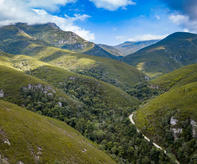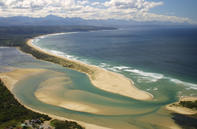Outeniqua Mountains
Khoi people sure seemed to have had an economical way with words: the name of the Outeniqua mountains apparently means 'man walking with a bag laden with milk and honey’ - a reference to the natural abundance of the laden with milk and honey area.

Today the milk is the amazing array of things to do, from golfing on world-class estates around George on the southern slopes and fabulous hikes on trails along the high ridges, to adventure touring on routes from one side of the Outeniqua to the other, via various mountain passes.
The honey is the hops that grow here, which are used to flavour all the beer made in South Africa - what's not to love about that! What is sometimes less appreciated is that although we talk with awe about the Knysna forests, most of the remaining temperate, Afro-montane yellowwood, forest in this country is actually found on the southern slopes of the Outeniqua Mountains, along the last few remaining mysterious 'Knysna' elephants.
Swartvlei
Of the five lakes and three lagoon estuaries that comprise the Garden Route Lake District, Swartvlei is the largest - and the only one of the so-called lakes that is actually a tidal lagoon. It is fed primarily by the Diep and Hoëkraal rivers that rise in the Outeniqua Mountains, and it empties into the sea at Sedgefield Beach, near Gericke Point.
The other lakes are, from east to west: Groenvlei, Rondevlei and Upper Langvlei, which flows into Lower Langvlei, otherwise known as Island Lake. Island Lake is linked to Touw River at Wilderness via the Serpentine channel, which does what it says it does: it meanders in tight squiggles through dense reed beds.
You can paddle around in a canoe and enjoy both the tranquillity and the shy water birds that otherwise live there undisturbed Fairy Knowe family hotel, close to where the Serpentine meets the Touw River, is a good spot to base yourself.
Keurbooms Lagoon

 The Garden Route is a great way to explore the Cape Coastal region of South Africa. You can either embark on a self drive route, lingering l...
The Garden Route is a great way to explore the Cape Coastal region of South Africa. You can either embark on a self drive route, lingering l... There are South African Tourism Routes to suit you. Read this quick concise guide by independent travel writer Carrie Hampton and choose a r...
There are South African Tourism Routes to suit you. Read this quick concise guide by independent travel writer Carrie Hampton and choose a r...